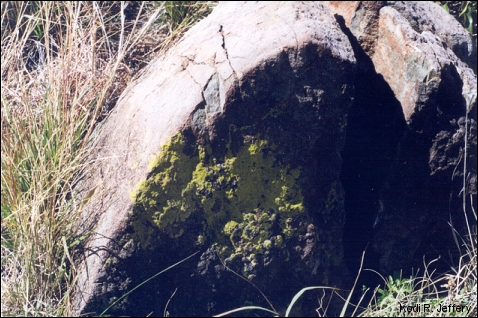

Ever notice colorful spots on rocks? Some rocks are literally covered with —something—something that is red, orange, yellow, or maybe grayish-green. These colors may look distinctly out of place in our desert, but their source plays an important part in the changing environment.
These colorful patches are lichens—organisms that are not really one
species, but a mixture of two! Spaghetti-like masses of fungi hold fast to rocks,
entangling plant-like algae or blue-green bacteria that provide food for both
themselves and the fungi through their photosynthesis. Thought by many to be a
beautiful case of mutualism, where two organisms survive by working together, some now
believe the food providers are unwilling partners. Perhaps the fungus has merely
captured them for a source of food, while providing nothing in return. Regardless of
who benefits, lichen works on the rock like no single species can. Over time, they
break down the rock surface until various plants can take root and eventually return
the boulders to the sand and dust from which they originally formed. So goes the
endless cycling of the desert.

Listen to the Audio (mp3 format) as recorded by KTEP, Public Radio for the Southwest.
Contributor: Kodi R. Jeffery, Centennial Museum, University of Texas at El Paso.
Desert Diary is a joint production of the Centennial Museum and KTEP National Public Radio at the University of Texas at El Paso.

Lichen (the yellowish-green) on a boulder in Big Bend. Photograph by Kodi R. Jeffery.